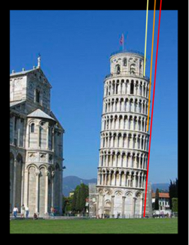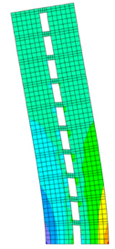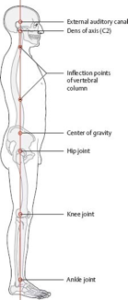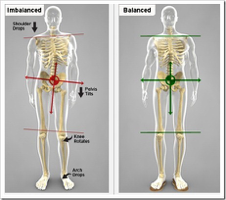Anything can cause anything....
Back in college, in the last century, one of my professors used to say:
“Ladies and gentlemen, always keep in mind anything can cause anything.”
It took me a couple of decades to fully appreciate his statement.
But what does it mean?
You see there is a thing called “gravity”.
So what is gravity?
According to Webster gravity is “the gravitational attraction of the mass of the earth, the moon, or a planet for bodies at or near its surface.”
This statement equally applies to anything and everything on this planet.
Let it be a blade of grass, an ant, human, elephant or a skyscraper.
All of these have to surrender to this law. The gravity pulls you down and there is nothing you can do about it. (except there was a famous gentleman about 2100 years ago who was walking on water. Yup … But the rest of us puny humans we have no chance…)
Here is what gravity can do for an unbalanced inanimate object:


As you can see from these pictures the higher you go the more you have deviated from the center. More deviation equals more stress that eventually leads to structural failure.

Now let’s see how this applies to the human bio-mechanics.
If you put a plumb line between your legs and the point is between your ankles, from the side you’d see the joints are stacked up nicely on top of each other.
Ankle over knee over hip over elbow over shoulder over ears. Boom. Straight shot.
The human center of gravity (CG) is the point where the human body rests under normal conditions without rotating, remaining balanced without active effort to remain upright.
An unstable center of gravity however requires only a small push to ruin someone's equilibrium, whereas a stable equilibrium is much stronger and can remain stable even under significant force.
So how can one’s CG become unstable?
Well look at your feet for example.
If your arches are stable you can stack your joints on top of each other nicely and our friend Mr. Gravity has no choice but pull you straight down and you can remain stable even under significant bio-mechanical stress.
If the joints are unsteady you start to deviate from the straight line and put unduly stress on your joints, as you see in the pictures below.
 Here your plumb line is not in the middle anymore. It has sheared off to the side.
Here your plumb line is not in the middle anymore. It has sheared off to the side.
The gravity pulls you down unevenly putting undue stress on the joints and consequently puts stress on the muscles.
Now you are fighting with gravity.
And trust me on this— you cannot win against gravity!
So gravity pulls you down you pull yourself up. Gravity pulls you down, you pull yourself up, gravity pulls you down, you pull yourself up, hundreds of times a day.
Eventually your muscles fatigue out and begin to cramp and turn off.
Have you noticed how frequently you have to change your stance while staying in line in the grocery store? Now you know why…
Guess what?
Your brain doesn't care how you remain upright as long as you are not falling on your face.
It says: “It doesn't matter who does what, she/he wants to walk/run/stand, whatever, without pain so get to work!”
Now you start recruiting the wrong muscles for the wrong reason in the wrong sequence. Eventually those guys fatigue because they have to do their neighbor’s assignment in addition to their own work.
And this goes on and on until you have no place to go to.
You see your body has the innate ability to heal itself as long as it has a place to compensate to or from.
The problem starts when you have no place to go to. You’ve run out of runway…
Can you see where this is heading?
Hello migraine!
Hello TMJ!
Hello low-back pain!
Hello constipation, menstrual cramps, tinnitus, numbness, tingling, chronic fatigue, diarrhea, eye strain, dizziness and the list can go on and on and on….
Now imagine you have an old house where the foundation is crumbling and you noticed your windows are cracking. Would you change the windows every month to fix the foundation?
See?
We were talking about ascending stress.
But what about the descending stress?
It certainly applies as well. If you have dental work done and one of your crowns or fillings is a bit too high then the occlusion will skew your bite pattern.
(Here is a little known secret. In order for you to swallow your teeth have to touch… Try to swallow while your mouth is slightly open… How about that huh..?)
Your teeth have to touch as perfectly as the gears line up in your car’s transmission.
And on the top of that, your Maxilla (the upper jaw) has to be level. If it is not in level you’ll hit hard on one side or the other putting undue stress on your jaw.
While you are resting at night, your brain tries to level your upper jaw in order to relieve the accumulated stress.
Ta-dah… You’ve just started to grind your teeth.
The muscles on the affected side will be under continuous stress that will create compensatory pain in the face, neck, shoulder, shoulder blade, mid- back, low- back, hip flexors and finally the knees.
OK. What about if it is starting in the middle.
Let’s say you’ve had a minor surgery like an appendectomy or a major operation like a hysterectomy.
You know you have scarring because you see it on you skin right?
Do you think you only scar on your skin? Of course not.
Scar tissue is a nasty creature more like a cobweb. It invades everything in its wake. The bigger the surgery, the nastier the scar is—like an aquatic plant that chokes everything around it.
Now imagine this cobweb, this aquatic plant wraps itself around your intestines.
For whatever reason you start to develop constipation. Why?
There is a funny little neurological law called the Arndt-Schulz law.
It states that weak stimuli excite physiological activity, moderately strong ones favor it, strong ones retard it and very strong ones arrest it.
So your scar tissue starts to irritate your colon that was humming along just fine until recently. Now the increased/moderately strong stimuli starts to inhibit/slow down the physiological activity, and if you are unlucky enough your friendly cobweb starts wrapping around your guts - guess what? - strong stimuli halt physiological activity.
Bingo!
Full blown constipation.
Or let’s go back to bio-mechanics.
Because your internal cobweb puts tension on your abdominal wall you have a tendency to bend forward just a little bit.
If you look at your feet while you are walking you will bump into things. We can’t let this happen. So another little known neurological law will kick into high gear. Lovett’s law. Your eyes have to be level.
Therefore the more you bend forward from the waist down the more the muscles of the back of your head have to pull your skull up for you to be able to look where you are going.
Can you say tension headache?
See? Anything can cause anything…

